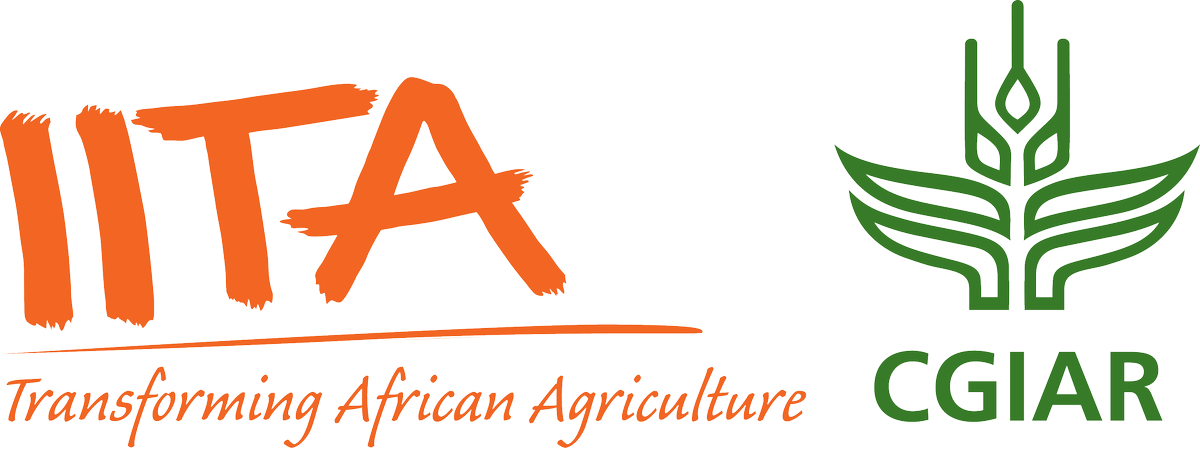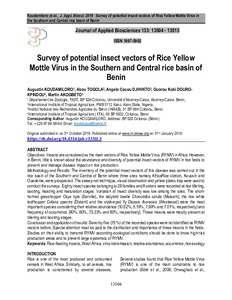| dc.contributor.author | Koudamiloro, A. |
| dc.contributor.author | Togola, A. |
| dc.contributor.author | Djihinto, A.C. |
| dc.contributor.author | Douro-Kpindou, O.K. |
| dc.contributor.author | Akogbeto, M. |
| dc.date.accessioned | 2019-12-04T11:33:10Z |
| dc.date.available | 2019-12-04T11:33:10Z |
| dc.date.issued | 2019-01-31 |
| dc.identifier.citation | Koudamiloro, A., Togola, A., Djihinto, A.C., Douro Kpindou, O. & Akogbeto, M. (2019). Survey of potential insect vectors of Rice Yellow Mottle Virus in the southern and central rice basin of Benin. Journal of Applied Biosciences, 133, 13504-13515. |
| dc.identifier.issn | 1997-5902 |
| dc.identifier.uri | https://hdl.handle.net/20.500.12478/5531 |
| dc.description | Open Access Journal |
| dc.description.abstract | Objectives: Insects are considered as the main vectors of Rice Yellow Mottle Virus (RYMV) in Africa. However, in Benin, little is known about the abundance and diversity of potential insect vectors of RYMV in rice fields to prevent and manage disease impact on rice production.
Methodology and Results: The inventory of the potential insect vectors of this disease was carried out in the
rice basin of the Southern and Central of Benin where three sites namely AfricaRice station, Koussin and
Ouedeme, were prospected. The sweep net technique, visual observation and yellow plates trap were used to conduct the surveys. Eighty insect species belonging to 28 families and 8 orders were recorded at rice tillering, booting, heading and maturation stages. Variation of insect diversity was low among the sites. The shorthorned grasshopper Oxya hyla (Serville), the ladybird beetle Chnootriba similis (Mulsant), the rice white
leafhopper Cofana spectra (Distant) and the stalk-eyed fly Diopsis thoracica (Westwood) were the most
important species considering their relative abundance (10.62%, 5.19%, 7.99% and 7.01%, respectively) and
frequency of occurrence (90%, 80%, 73.33% and 80%, respectively). These insects were mostly present at
tillering and booting stages.
Conclusion and application of results: Seventy-five (75 %) of the recorded species were not identified as RYMV vectors before. Special attention must be paid to the distribution and importance of these insects in the fields. Studies on their ability to transmit RYMV according ecological conditions should be done to know high-risk production areas and to prevent large epidemics of RYMV. |
| dc.language.iso | en |
| dc.rights | CC-BY-4.0 |
| dc.subject | Rice |
| dc.subject | Feeding |
| dc.subject | Insects |
| dc.subject | West Africa |
| dc.subject | Virus |
| dc.subject | Transmission |
| dc.subject | Ecology |
| dc.title | Survey of potential insect vectors of Rice Yellow Mottle Virus in the southern and central rice basin of Benin |
| dc.type | Journal Article |
| dc.description.version | Peer Review |
| cg.contributor.crp | Rice |
| cg.contributor.crp | Grain Legumes |
| cg.contributor.affiliation | Université d'Abomey-Calavi |
| cg.contributor.affiliation | International Institute of Tropical Agriculture |
| cg.contributor.affiliation | Institut National des Recherches Agricoles du Bénin |
| cg.coverage.region | Africa |
| cg.coverage.region | West Africa |
| cg.coverage.country | Benin |
| cg.creator.identifier | Abou TOGOLA: 0000-0001-6155-8292 |
| cg.researchtheme | PLANT PRODUCTION & HEALTH |
| cg.authorship.types | CGIAR and developing country institute |
| cg.iitasubject | Pests Of Plants |
| cg.iitasubject | Plant Diseases |
| cg.journal | Journal of Applied Biosciences |
| cg.howpublished | Formally Published |
| cg.accessibilitystatus | Open Access |
| local.dspaceid | 104136 |
| cg.targetaudience | Scientists |
| cg.identifier.doi | https://dx.doi.org/10.4314/jab.v133i1.3 |

